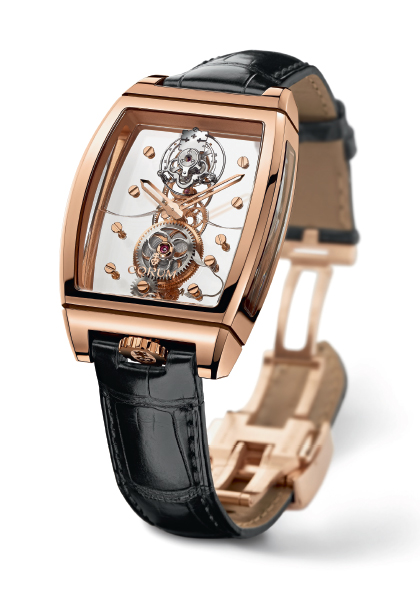The vast majority of watches on the watchmaking market are round, and are thus naturally associated with round movements, which also account for the lion’s share. So when a movement shaped more like an I than an O appeared in a rectangular case, it came like a bolt from the blue – and met with acclaim. The approach may appear to be purely aesthetic, reflecting a designer’s desire to stand out from the crowd, or that of a brand to boast one of those much-touted ‘talking pieces’ that create a stir without anyone actually buying one. But for Corum’s Golden Bridge Tourbillon, nothing could be further from the truth. First unveiled in 2010, it was designed around one of the major feats of contemporary watchmaking: the baguette movement. The main achievement here is managing to arrange interlocking parts that are basically circular (the gears) into a perfectly linear calibre.
Straighter - and Smaller
The lightweight baguette movement, reduced to its essential minimum, was developed by independent watchmaker Vincent Calabrese in 1977. Calabrese had only one tenet: his watch should be admired above all for the beauty of its mechanism – in other words, for its calibre.
The baguette movement was the result of this conviction. Corum purchased the rights to it, and the first Golden Bridge was produced in the early 1980s. 2010 marked a turning point for the model; it was the watch’s 30th anniversary, and Corum’s 55th. The brand took the opportunity to bring out a new version of its GB, equipped with a tourbillon sporting a silicon escapement positioned at 12 o’clock. With a cage just 8.5 millimetres in diameter, it was the second-smallest tourbillon in the world.

The Art of the Ethereal
With this creation, the tourbillon acquired both a new look and new technical features. Aesthetically, there was its perfectly-balanced, vertical design, in which the tourbillon at 12 o’clock echoes the barrel at 6 o’clock. The crown is at 6 o’clock too, in direct contact with the barrel. The assembly is contained in a very uncluttered, barrel-shaped tonneau case with no flange. The technical achievement resides in the creation of an upright, linear movement that manages to be visually harmonious despite being composed of circular gears.
Two years later, in 2012, Corum developed its Panoramique version, complete with flying tourbillon. A skeleton approach was adopted for the components of this timepiece, enhancing the ethereal aspect of the baguette movement, as does the flying tourbillon: devoid of an upper bridge, it appears lighter, freer, and still more essential. The tourbillon cage features the brand’s signature key emblem as well as an impressive 90-hour power reserve, nearly double the standard length at the time.
Corum also chose to use sapphire for the bridges and mainplate, enabling light to pour through the unique movement architecture. All in all, the CO 100 calibre provides an outstanding upright setting for the tourbillon that is as yet unrivalled in watchmaking.
*This year GMT Magazine and WorldTempus have embarked on the ambitious project of summarising the last 20 years of the Tourbillon in The Millennium Watch Book - Tourbillons, a big, beautifully laid out coffee table book. This article is an extract. The Millennium Watch Book - Tourbillons is available on www.the-watch-book.com, in French and English.





